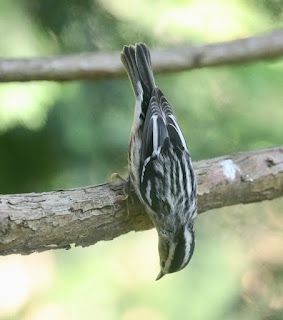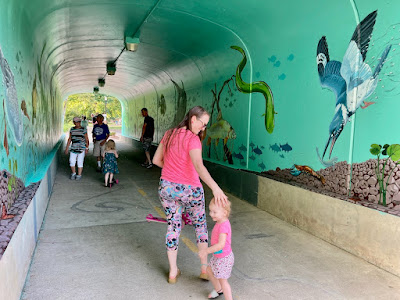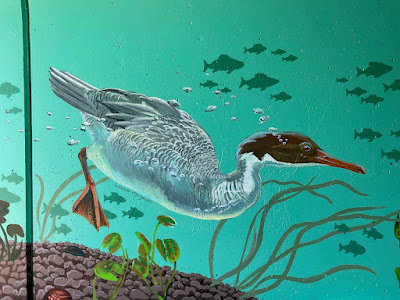Meet the Mint Humbug
Pssst. Fall migration is in full swing. While you're asleep, warblers by the hundreds and thousands are slipping through the treetops, silently making their way toward Central America. Getting out before the frost comes, giving themselves plenty of time to travel in night skies, dropping down to forage in insect-laden leaves at daybreak. It's Fat City out there, the best time to travel, when caterpillars and crickets and spiders and aphids are everywhere.
When there are redstarts on the roof, the move is on. You hear their lisping calls in the sky each morning. Watch the trees, see them cartwheeling through.
This little immature female black and white warbler has eaten her share of spiders, I am certain. She's clinging to the trunk of a golden Chamaecyparis right outside my studio window. If she recalls a nuthatch in her stance, that's no accident. This is the warbler who lives like a nuthatch.
Black and white warblers spend a lot of time hanging head-down and hitching around on the bark and limbs. As such, they have strong legs and large feet.
Mniotilta is treated as monotypic because of morphological adaptations for vertical (tree trunk) foraging (Parkes 1978), adaptations that include an elongated hallux, roughly as long as the tarsus (Ridgway 1902).
Translated, that means that the hind toe of this bird is nearly as long as its leg! Check out that feature on this white-breasted nuthatch, also shot from my studio window:
Isn't it neat to see the congruencies of behavior, coloration and structure in these two unrelated species, based on the similarity in how they make their living? Convergent evolution, y'all. It makes the world go around.
Disruptive coloration, black and white striations resembling tree bark, help break up the bird's form as it works the bark. Even the undertail coverts are spotted. I noticed that this young female's nails are a fetching golden color. Now I want to check every black and white warbler to see if that color stays into adulthood. Look at those golden grappling hooks!
From my friend John Kricher's account in Birds of the World (formerly Birds of North America), I learned that the "distal toepads (are) usually notched, a possible adaptation for bark foraging (Clark 1973b)" Blowing up my photo, I see a teeny weeny notch just anterior to the fattest part of the big toe pad. Do you?
Nice to have a black-and-white warbler so close that you can grab a photo of the notches in its distal toepads!
The black-and-white warbler is famous as a vagrant, showing up somewhat regularly in fall in Britain and Ireland. You can imagine how that thrills European birders, who are accustomed to waxing poetic about the drabbest of their hopelessly drab warblers. When you've been rhapsodizing about birds that look like this...
Great Reed Warbler, Wikipedia Commons. A lovely bird, but no Mint Humbug.
...imagine THIS striped beauty showing up, knocking everyone's damp woolen socks off.
Ah, Facebook. Beneath one photo I posted there, I got this comment from Megan Crewe, a bird tour leader for Field Guides, Inc:
"Did you know that the British birders' nickname for these little sprites is "Mint Humbug"? That's a black-and-white peppermint candy here."
Naturally, I had to check and see why...Waah hahaha!!!
Leave it to the British to come up with such a perfectly droll name for our gorgeous warbler. Mint Humbug. I can see them, whispering in code, so the rarity-seeking throng can't hear. "Psst. Mint Humbug, working a large beech, corner of Gloucester and Wembly, still there as of 1400 hours Tuesday." Thank you for that smile, Megan!!
I am delighted to say that these little darlings breed in my southeast Ohio forest. In the spring of 2020, rainy, cold and wet as it was, I watched a pair constructing a nest in the newly-cleared farthest reach, among the black maples. They were tucking wads of bark-fluff and moss at the base of tree trunk. What a weird place for a warbler nest, but then black-and-white warblers are among the weirdest of warblers. Ground nesters--with all these chipmunks and snakes and raccoons...arrrgh. Yet somehow they persist. I never knew if the 2020 nest was successful; I was not about to walk up to it and lead predators there. Plus, I was too busy feeding starving migrants and bluebirds that awful, freezing cold, rainy May. The black-and-whites were back in 2021, voicing their squeaky-wheel song in the tulip grove just off the lower path in the orchard, and though I rarely caught so much as a glimpse of them, that squeaky song made me smile so big. Knowing they were there was everything.
I'd love to think this little gal was hatched here, but in the fall, one never knows. The black-and-whites and all the other warblers are streaming through now. Go out, willya, and catch the show.
|
Widget for blogger by Way2Blogging | Via Spice Up Your Blog Gadgets
|
Finishing Up: The Marietta Mural
Thursday, August 26, 2021
8 commentsI was very excited to paint my last creature in the tunnel, and to have that creature be a BIRD. It makes me smile to think of how I managed to work two birds and two mammals into an underwater mural that could reasonably be expected to consist entirely of fish and turtles, but hey. Biodiversity is the spice of life, and birds fly underwater, too!
I found some absolutely amazing photos online, taken by Alan Murphy in Texas. They are surpassingly beautiful, with crazy water swirls and bubbles and distortion. I would have loved to play more with those motifs, but I just didn't have time--we drew and painted the whole durn tunnel in four huge days, from the first projection to the final brushstroke (laid down, of course, by Perfectionist Me).
But this photo was my inspiration.
Photo by Alan Murphy
I changed the head and gave it a tail...I'm not sure where the tail is on the reference photo. Lost in a swirl of bubbles! Throughout, I wanted to bring some action into the mural, and the sudden arrowing splash of a belted kingfisher seemed like the perfect vehicle.
Laying down base coats.
By end of day Thursday, August 12, I thought I was done with this bird. It looked pretty fly, I thought.
I asked Beth Nash to come over and give it some swirly bubbles, because I was too much of a perfectionist to just have fun with it. I was still fussing over feathers.
It's kind of a big deal for someone like me to turn over their painting to someone else and say, "Have at it!" but that was one of the big lessons of this project for me. More is better. Community is vital. There are much better painters out there than me. Like Beth Nash! Let go, give someone else a whack at it.
Here's organizer/visionary Bobby Rosenstock's Instapost about it. He's @justajar on IG.
One of the most frequently asked questions from the good people of Marietta who peeked in on us as we worked was, "How you gonna keep people from ruining it? Gonna put some kind of a coating on it?"
It was a fair question, and it was the first thing I wondered when I contemplated giving heart and time to such a big project. And I have to say, having nearly everyone who came by to look ask us the same question was disheartening. Especially after our first morning of drawing. After it was power-washed and spanking clean, Bobby and the Marietta Noon Rotary painted the tunnel an even aqua blue inside. And on the very first night the blue went on, the night before we all came in to start drawing on the walls, someone came through the tunnel with a brick, hurling it against the freshly painted walls, scarring and denting them. How's that for a kick-off on your first morning of mural painting ever? It made us sick, but we all gritted our teeth and pressed forward, hoping that the quality of our work would give even the brick-hurler pause before they destroyed it.
But just to be sure, there's VandlGuard on it.
The mural survived the week between being painted and being protected, thank goodness! And during that week I looked at photos I'd taken of my work, thinking about what might still need to be done. Something about the kingfisher was buggin' me. Finally it hit me: I'd forgotten to paint bars on its underwings, and upperwings, too! and it was too white! Aack!
So I went and got three jars of mural paint from Bobby (black, white, and background aqua); grabbed some brushes and supplies; and headed down there on a Friday afternoon to set things aright. Ahhh! All better. Now it looks right to me.
Finally, on this last painting, I had gotten the hang of working with acrylics on cement. I figured out how to thin the paint down and layer washes, sort of like I do in watercolor. I made a million little adjustments, tickled in all those intricate markings on the underwings and secondaries and tail, and brought a blue-gray wash down the near wing and over the flank. Yes, the eye looks weird. That's because when a kingfisher dives, it blinks back a translucent nictitating membrane over its eyes for protection. Sure, I could have made the eye shiny black, but it wouldn't have been right. I like the demonic look.
When I was finally done with the kingfisher, I did a little touch-up on the diving merganser.
Unless I pointed it out, you might not notice the person with upraised arms that I painted over, legacy of the old mural.
And there's another one next to it. Looks like they were having trouble with the paint, and kept glopping it on. The result was some impasto people that made me think of the Pompeiian volcano, those haunting casts in the hot ash that caught people in their beds. You think about a lot of things while painting large birds.
You can see the Pompeiians, but barely. Most people won't even notice. It didn't bother me one bit. That was then, this is now.
Artist Bonie Bolen added a nice crayfish near my kingfisher. It was great to see her again--we knew each other years ago, since her legendary dad Cobbler John headed up the Blues, Jazz and Folk Music Society in Marietta. Those were the days! And Leah Seaman painted those rocks in nothing flat. I definitely could not have done that. Follow her @artabella on Instagram. She just finished painting a Porto-Let and it is awesome!!
Though I wouldn't have wanted to paint the whole thing with the public walking right through, it was fine while I was finishing up the kingfisher. I got asked a ton of questions, but mostly people were just so happy to see the mural and tell me how much they liked it. That was Really Nice.
Watching people make a point of bringing their kids to see the mural was my favorite thing of all. Just knowing that it would be a destination for little kids warmed our hearts. And I got to paint with my kid. Nothing beats that.
His eel, my kingfisher, together forever. :) Or until the next flood, I suppose. That's OK. I'd paint it all over again in a heartbeat.
The Putnam Street Tunnel gone from a pedestrian and bicyclists' passage to a destination, and we are so proud to have made it fun and beautiful.
Thanks to Bobby Rosenstock for coming up with the idea, swinging the grant, and pushing it all through. And for bringing the music and Sara's baked goodies that kept us going. Whatta guy!!
Here, Bobby starts off by describing the art he made in school--always wanting to surround the viewer with art. I love this little impromptu video--it captures his unique way of looking at the world, his out-of the box thinking. And the fun of painting and dreaming together.
On Friday, September 3, 2021, there will be a little ceremony, a ribbon-cutting for the mural from 5-6 pm. Come on down and meet the artists, then enjoy Marietta's First Friday, strolling up and down our lovely downtown streets.
|
Widget for blogger by Way2Blogging | Via Spice Up Your Blog Gadgets
|
Let's Paint an Eight-foot Duck!
Sunday, August 22, 2021
3 commentsI'd like to give you an up-close look at the process of painting a common merganser, about eight feet long.
I found some cool videos online of mergansers underwater. Things happen to colors underwater, as you can see...everything goes gray and dull and silvery. So there's a lot of lying here about the clarity of the water and the lighting, too. There's a push and pull between wanting to show it as it really would look and wanting to give it the detail and color that will make a satisfying image for people to enjoy.
My sketch, which got blown up with a digital projector. I have a hazy idea of how the feathering would go.
I started slapping paint on this the same afternoon I finished the Problematic Otter. It felt so dang good to be painting a bird at last. It didn't matter that it was bigger than me. I was just so happy to be out of the mocha mud of fur. Don't get me wrong--I'd be glad to paint more otters.
But birds are where I live and breathe.
I blocked out the colors and markings. It went very fast. As you can see I am wearing one of my finest T-shirts, the better to get paint all over it.
photo by Sarah Arnold, courtesy clutchmov.com
Within a couple of hours, it looked like a merganser. And then all the light was gone and it was time to go home. We painted in the tunnel by natural light only, and it was quite a challenge in the middle of the passage. Much more fun to paint at the ends!
I took this photo of it (below) to take home and ponder, because something about it was bugging me. It's an enormous boon to be able to take a digital photo and look at something very large, reduced to very small. When I was doing a lot of illustration, I used a reducing glass to look at my drawings to see how they'd look when reproduced. Same deal here. Things jump out at you that you can't see when you've got your nose to an enormous duck on an enormous wall.
And what jumped out at me was that it looked flat. The shadow running along the bottom wasn't relevant to the overall form. And the feather tracts divided the form up into sections that kind of lifted off the form, and distracted from its overall shape. Hmm. After sleeping on it, I had the solution. I came in the next morning, fresh, and decided to define the overall form of the bird with feathers. Everyone around me was painting scales.
I decided I would paint some feathers, even though you can't see individual feathers on a diving merganser. I had to round out that form, and the feathers would travel over it and tell of its shape. I sought out some photos that would tell me the size and direction of the feathers, because none of that was evident in my blurry video grab of a diving bird.
And when the feathers traveled over the surface of the bird, it was suddenly more rounded, solid, more beautiful to my eye. Not only that, but I could reach most of it without a ladder! Heaven! I'm painting a huge bird, and I can reach all of it without risking a fall! (I'm storing away these observations for future mural projects. The others were all painting at eye level--it seemed like my stuff was mostly huge and high up!)
photo by Michelle Waters, courtesy clutchmov.com
Add some silvery bubbles, and that duck is paddling underwater. I added a little eelgrass, too.
As you enter the tunnel from the south, this is the scene to your left.
I was happy with my merganser, and looking forward to finishing with a bang--painting a diving belted kingfisher nabbing a chub!
|
Widget for blogger by Way2Blogging | Via Spice Up Your Blog Gadgets
|






















































Tuesday, August 31, 2021
5 comments